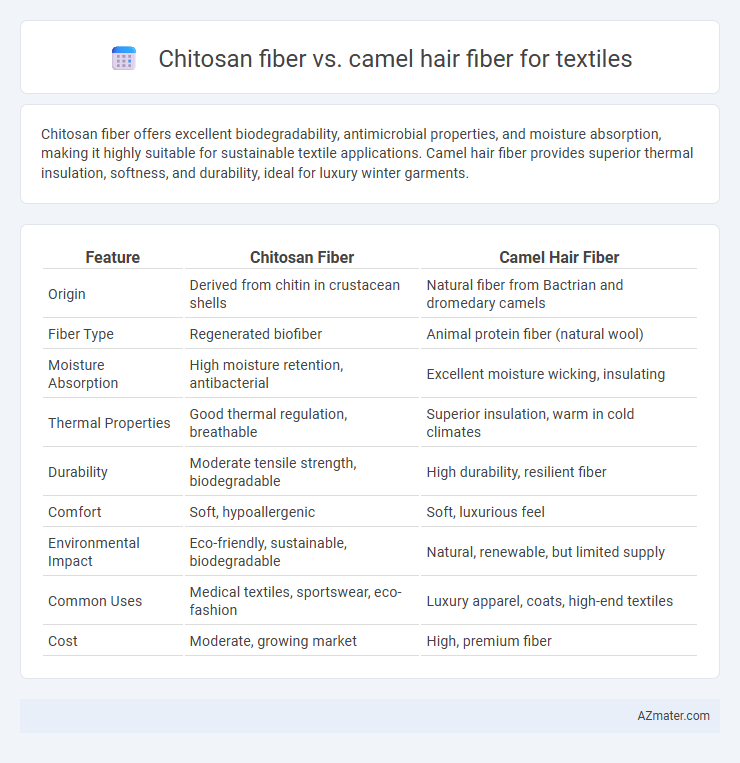Chitosan fiber offers excellent biodegradability, antimicrobial properties, and moisture absorption, making it highly suitable for sustainable textile applications. Camel hair fiber provides superior thermal insulation, softness, and durability, ideal for luxury winter garments.
Table of Comparison
| Feature | Chitosan Fiber | Camel Hair Fiber |
|---|---|---|
| Origin | Derived from chitin in crustacean shells | Natural fiber from Bactrian and dromedary camels |
| Fiber Type | Regenerated biofiber | Animal protein fiber (natural wool) |
| Moisture Absorption | High moisture retention, antibacterial | Excellent moisture wicking, insulating |
| Thermal Properties | Good thermal regulation, breathable | Superior insulation, warm in cold climates |
| Durability | Moderate tensile strength, biodegradable | High durability, resilient fiber |
| Comfort | Soft, hypoallergenic | Soft, luxurious feel |
| Environmental Impact | Eco-friendly, sustainable, biodegradable | Natural, renewable, but limited supply |
| Common Uses | Medical textiles, sportswear, eco-fashion | Luxury apparel, coats, high-end textiles |
| Cost | Moderate, growing market | High, premium fiber |
Introduction to Chitosan and Camel Hair Fibers
Chitosan fiber, derived from the biopolymer chitin found in crustacean shells, is valued in textiles for its biodegradability, antibacterial properties, and moisture absorption. Camel hair fiber, harvested from the undercoat of Bactrian camels, is prized for its lightweight warmth, softness, and natural insulation. Both fibers offer sustainable, natural alternatives in textile manufacturing, with chitosan emphasizing functionality and camel hair focusing on comfort and thermal regulation.
Source and Extraction Methods
Chitosan fiber is derived from chitin, primarily extracted from crustacean shells using deacetylation processes involving chemical treatment with alkali solutions, making it a sustainable biopolymer in textiles. Camel hair fiber originates from the undercoat of camels, collected through natural shedding or shearing, and undergoes mechanical cleaning and dehairing methods to separate fine fibers suitable for high-quality fabric production. The extraction of chitosan fiber relies on chemical methods to transform waste products into functional fibers, while camel hair fiber extraction is more traditional and manual, preserving the natural properties of animal hair.
Physical and Chemical Properties Comparison
Chitosan fibers exhibit excellent biodegradability, strong antimicrobial properties, and high tensile strength, making them suitable for sustainable textile applications. Camel hair fibers are prized for their natural warmth, lightweight texture, and superior moisture-wicking capabilities, attributed to their unique hollow medulla structure. Chemically, chitosan fibers possess amino groups that enhance dye affinity and antibacterial functions, whereas camel hair fibers are rich in keratin proteins, providing resilience and softness.
Biodegradability and Environmental Impact
Chitosan fiber, derived from chitin in crustacean shells, offers excellent biodegradability, breaking down rapidly in natural environments and reducing long-term waste. Camel hair fiber, though natural and biodegradable, decomposes more slowly due to its protein structure and has higher environmental costs linked to animal husbandry. Chitosan fiber's antimicrobial properties further enhance its eco-friendly profile by reducing the need for chemical treatments in textiles.
Moisture Absorption and Thermal Regulation
Chitosan fiber exhibits superior moisture absorption due to its hydrophilic amino groups, allowing it to retain and release moisture efficiently, which enhances wearer comfort in textiles. Camel hair fiber, naturally rich in lanolin, provides excellent thermal regulation by trapping air within its hollow structure, offering insulation in cold conditions while remaining breathable. Combining chitosan's moisture management with camel hair's thermal properties creates advanced textiles ideal for temperature and humidity-sensitive environments.
Strength, Durability, and Wear Resistance
Chitosan fiber exhibits superior strength and wear resistance compared to camel hair fiber, making it more durable for high-performance textile applications. Its biopolymer structure enhances fiber tensile strength and resistance to abrasion, outperforming the natural protein-based camel hair which is softer but less resilient under stress. The enhanced durability and longevity of chitosan fibers make them ideal for activewear and industrial textiles where extended wear resistance is critical.
Comfort and Skin Sensitivity
Chitosan fiber offers exceptional comfort due to its natural antibacterial properties and moisture-wicking ability, making it ideal for sensitive skin and reducing irritation. Camel hair fiber provides excellent softness and thermal insulation but may cause discomfort for those with skin sensitivities due to its coarser texture. Textile products designed with chitosan fiber are favored for hypoallergenic qualities, enhancing skin comfort in comparison to camel hair.
Dyeability and Aesthetic Qualities
Chitosan fiber exhibits superior dyeability due to its abundant amino groups, allowing vibrant and long-lasting color absorption compared to camel hair fiber, which has a natural, muted hue that limits dye options. Camel hair fiber is prized for its soft texture and luxurious luster, offering rich, earthy tones that enhance aesthetic appeal without extensive dyeing. Chitosan fiber's ability to bond with a wide range of dyes and its antimicrobial properties make it ideal for colorful, functional textiles, while camel hair's insulating properties and natural elegance suit high-end, undyed garments.
Applications in Textile Industry
Chitosan fiber exhibits strong antimicrobial properties and biodegradability, making it ideal for medical textiles, sportswear, and hygiene products where odor control and skin-friendliness are critical. Camel hair fiber offers exceptional insulation, softness, and moisture-wicking capabilities, commonly used in luxury garments, winter wear, and high-end upholstery fabrics. Textile manufacturers often blend chitosan fiber with camel hair to enhance durability and functionality while preserving comfort and natural warmth.
Future Trends and Innovations
Chitosan fiber is gaining rapid traction in the textile industry due to its biodegradability, antimicrobial properties, and sustainable production from crustacean shells, making it a prime candidate for eco-friendly fabric solutions. Camel hair fiber, valued for its exceptional thermal insulation, softness, and moisture-wicking abilities, remains a luxury natural fiber with innovations focusing on blending for enhanced durability and comfort. Future trends predict a convergence where chitosan fiber's functional benefits meet camel hair's premium qualities through bio-engineered hybrids and advanced fiber treatments to revolutionize sustainable and high-performance textiles.

Infographic: Chitosan fiber vs Camel hair fiber for Textile
 azmater.com
azmater.com